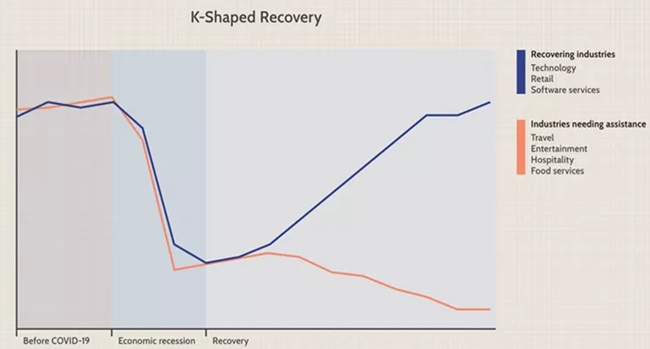Reference
Like the post-pandemic recovery, the Indian inflation curve is also ‘K-shaped’, hurting some segments more than others, according to a report by HSBC titled “India’s K-shaped inflation: What does it mean for policymaking?”
India's K-shaped inflation
- According to HSBC researchers, the uneven K-shaped recovery in economic growth is fuelling a similar trajectory for inflation dynamics in India.
- In this sequence, inflation in goods and services is being outpaced by food and rural price rise and inflation faced by urban consumers respectively.
- Rural consumers are more affected by this type of price increase than urban consumers.
- There has been considerable concern about India's recovery since the pandemic, as demand for high-end goods and services has increased while mass consumption goods preferred by lower-income households have seen a relative slowdown.
- Apart from the dichotomy between rural and urban inflation and food prices being higher than other commodities, inflation of goods is higher than that of services and input prices are rising more than output prices.
- The report points out that farmers' incomes have been affected, leading them to make greater efforts to sell food grains to urban buyers where they can get greater profits.
- This is reducing supply in rural areas, thereby increasing prices.
Key factors of K-shaped inflation
- 2023 was an El Niño year, which led to a rise in food inflation but India's economy saw a sharp decline in core prices. The following are the key factors:
- The fall in commodity prices led to a decline in input prices, resulting in producers being able to cut output prices without sacrificing profitability.
- The Indian economy has benefited from declining inflation in China. Between falling export prices and rising export volumes in China, an economy like India has seen inflation weaken to some extent.
- Services inflation in India has remained low, keeping core prices in check.
- Also important has been the central bank's accommodative policy. The RBI has repeatedly reiterated its objective of reaching a 4% inflation target. The RBI has raised rates twice despite low inflation in an effort to stabilize the rupee.
What K-shaped inflation means for policy making
- The government has helped reduce inflation by reducing prices of many fuels, but many fuels like petrol, diesel and LPG are not as commonly used in rural areas as in urban centres, which is why inflation in rural areas is much higher than in urban areas.
- The government needs to be more sensitive to the impact of policy changes on different groups already grappling with supply-side shocks.
- Supply-side risks continue to grow, so monetary policy making and reforms may need to be adjusted.
- According to the report, a better monsoon may provide some scope to the Reserve Bank of India to ease monetary policy, which could lead to softening of food inflation.
- A poor monsoon could make the food crisis of 2024 worse than that of 2023, as granaries are low on stocks of wheat and pulses.
- There should still be room for interest rate cuts even if medium-term pressures from “recurring and overlapping” climate events persist, the report suggests.
What is a K-shaped recovery?
- A K-shaped recovery occurs when different parts of the economy return to normal at different rates, times, or magnitudes after a recession. This is in contrast to a uniform recovery across sectors, industries, or groups of people.
- This type of recovery is called K-shaped because the paths of different parts of the economy can differ when charted together, resembling the two arms of the Roman letter "K."
- A K-shaped recovery shifts the structure of the economy or broader society as economic outcomes and relationships change fundamentally both before and after the recession.

India's K-shaped recovery
- India's economy has seen a K-shaped recovery post-Covid, as two new sectors emerged during the pandemic.
- First, high-tech exports of both goods and services increased.
- Second, there was a growth in tech start-ups, which attracted foreign capital into the economy and provided digital solutions to real economy problems.
- India's K-shaped recovery has not seen strong low-to-mass-level consumption, keeping demand for services in check.
|


